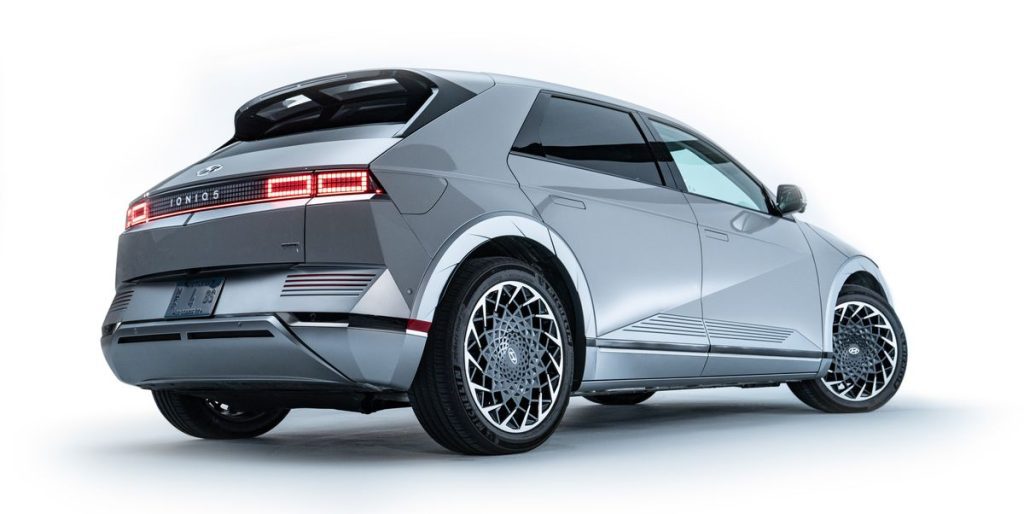Presenting Car and Driver's 2022 EV of the Year

John RoeCar and Driver


C/D Test Results at a Glance
60 mph: 4.5 sec
1/4-Mile: 13.2 sec @ 102 mph
Braking 70–0 mph: 170 ft
Roadholding, 300-ft Skidpad: 0.85 g
Highway Range: 210 mi
If you want to know why the Hyundai Ioniq 5 is our EV of the Year, just look at it. Is this not the coolest new design on the road? Just when you thought the two-box crossover shape was permanently consigned to amorphous wind-tunnel blobbiness, along comes this collection of slashes and rectangles, all rakish and defiant but somehow still scoring a relatively slippery 0.29 coefficient of drag. This is high design for the masses, right down to the exotic-looking matte-gray paint—a $1000 option. Yes, that’s all. The Ioniq 5’s pricing, which starts at $41,245, is the only thing about it that’s resolutely normal.
This car is confidently weird. The driver’s seat has a power leg rest? Okay! The center console slides back 5.5 inches, so you could climb into either front seat from either side, should that need arise. You can also drive the car forward or back using the key fob, proving Hyundai’s commitment to squeezing into inadvisable parking spaces. The cruise control pays attention to how you drive, so it can try to emulate your style (alternately, it can be manually configured for “angry Boston guy rushing to buy Powerball tickets”). When you plug in, a disembodied voice booms “charging started” from somewhere beneath the car. You can turn that down, or off, but it’s fun to startle people at public chargers with your assertive talking car.
With its standard 58.0-kWh battery, the Ioniq 5 is good for 220 miles of EPA-rated range. The larger battery (77.4 kWh) delivers 303 miles of range in rear-drive models and 256 miles in all-wheel-drive cars. Those numbers aren’t class-leading (the EPA rates the Tesla Model Y Long Range at 330 miles), but that doesn’t matter so much given the Hyundai’s 800-volt architecture and consequently rapid charging ability—a 350-kW charger can blast the larger of the two battery packs from a 10 to 80 percent state of charge in 18 minutes. Hyundai’s battery, supplied by SK Innovation, is also able to act like a generator; Hyundai calls this vehicle-to-load capability. With an outlet ahead of the rear seat and an adapter that plugs into the charge port, you’ve got 1900 watts available for tailgating or keeping your fridge cold during a power outage. That feature could also be a boon for camping, and in fact the Ioniq 5 can haul a tidy little teardrop trailer: Its tow rating is a modest but useful 1650 pounds.
You’d hope that our EV of the Year would be fun to drive, and the Ioniq 5 doesn’t disappoint there either. In all-wheel-drive form, it hits 60 mph in 4.5 seconds, just 0.2 second behind a Ford Mustang Mach 1. And that launch doesn’t require any finicky preparation, as evidenced by the 4.8-second 5-to-60-mph time. The Ioniq 5 feels like it’s rear-drive, happy to hang its tail out. Of its 320 total horsepower, 221 horses come from the rear motor and 99 from the front. In fact, when you’re not deep on the accelerator, the Ioniq is rear-wheel drive, as it’ll show you via the instrument-cluster drivetrain graphic that depicts real-time power delivery to the four contact patches. Traction and stability control are fully defeatable, usually a sign of a car that’s ready to party. This thing on winter tires, in a few inches of fresh powder, will be a riot.
And when you’re not driving like you’re on a Rally Finland stage, the Ioniq can morph into a supremely comfortable cruiser. Its 67-decibel interior sound reading at 70 mph is just a decibel higher than that of a Bentley Bentayga S—when it’s raining, you really notice the slap of the windshield wipers because that’s all there is to hear. The interior feels huge, a function of the lavish 118.1-inch wheelbase, which is full-size-SUV territory. Hyundai doesn’t make a big deal about its Highway Driving Assist 2 system (which combines adaptive cruise and lane centering), but it’s one of the best in the business and feels like it would be ready to go hands-free with the addition of a driver-monitoring camera. It even helps with lane changes—give the steering wheel a nudge and the car smoothly slides over for a pass. The head-up display has an augmented-reality mode, if you need a break from regular reality. As with the exterior styling, the Ioniq 5’s interior feels like a concept that probably won’t make it to production. Except it already did.
Fails? The tiny frunk—effectively a briefcase sitting atop the power-electronics hardware—is a joke, and the turning circle is unusually huge, about a foot more than that of a base GMC Yukon. The rotary stalk shifter also requires acclimation.
But so what? The Hyundai Ioniq 5 feels like the future. And the future is good.






